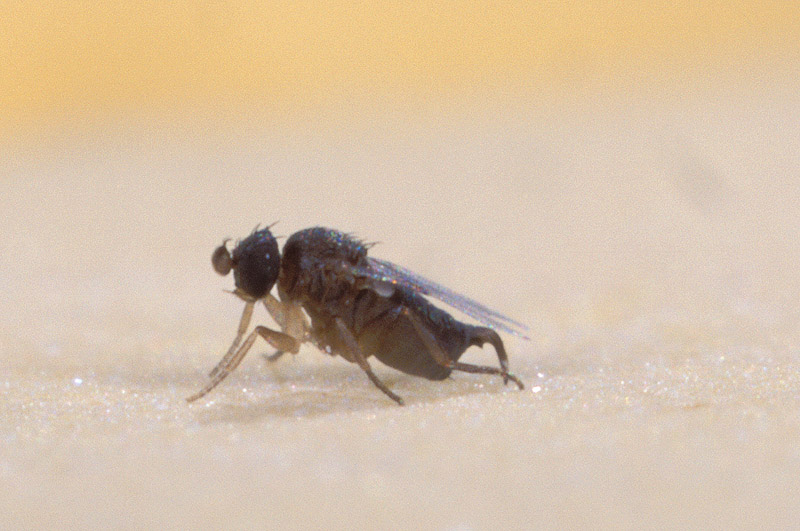 Phorid Flies, also known as Scuttle Flies or Humpbacked Flies, often show up in terrariums housing reptiles, amphibians and invertebrates. Usually confused with Fruit Flies, these little pests feed upon meat-based foods and organic waste and are classified in the 4,000+ member insect family Phoridae. The most commonly encountered species in US collections is Megacelia scalaris, and an outbreak can range from a mere annoyance to a serious problem. Please see Part 1 of this article for further information. Today we’ll examine some simple methods of controlling these and related flies.
Phorid Flies, also known as Scuttle Flies or Humpbacked Flies, often show up in terrariums housing reptiles, amphibians and invertebrates. Usually confused with Fruit Flies, these little pests feed upon meat-based foods and organic waste and are classified in the 4,000+ member insect family Phoridae. The most commonly encountered species in US collections is Megacelia scalaris, and an outbreak can range from a mere annoyance to a serious problem. Please see Part 1 of this article for further information. Today we’ll examine some simple methods of controlling these and related flies.
‘House-Keeping”
The easiest way to control Phorid Flies and other vermin is to quickly remove all fecal material, dead feeder insects, and meat-based food remains. This is, of course, essential in maintaining the health of your collection as well.
Humidity and Moisture
Phorid Flies are rarely a problem around desert-dwelling pets, as they cannot tolerate arid environments. Allowing terrariums to dry out a bit, if such is safe for the inhabitants, is an effective control measure. In the case of large populations in complex terrariums that are difficult to dismantle, it may be advisable to relocate your pets for awhile, so that the enclosure can thoroughly dry-out.
Traps and Barriers
A trick I used to increase the effectiveness of fly paper is to coat it with a bit canned beef or chicken gravy. In doing this, however, you run the risk of attracting flies that were not already present in the area…so save the technique for severe infestations!
 Commercial insect screening, designed to exclude tiny flies, is available. However, I’ve found that Phorid Flies are very good at circumventing physical barriers, and usually find a way in. Also, insect screening may not provide adequate ventilation for certain reptiles and amphibians.
Commercial insect screening, designed to exclude tiny flies, is available. However, I’ve found that Phorid Flies are very good at circumventing physical barriers, and usually find a way in. Also, insect screening may not provide adequate ventilation for certain reptiles and amphibians.
Further Reading
Phorid Flies as Turtle Egg Predators
 That Reptile Blog – Reptile, Amphibian and Exotic Pet Care and Information
That Reptile Blog – Reptile, Amphibian and Exotic Pet Care and Information



Hi Frank,
Is there any other means to eliminate this pesky pests? It already killed one of my adult hottentotta hottentotta and adult male mesubuthus martensii.
Hello, Frank Indiviglio here.
Thanks for the note and info; I’ll keep you posted if anything new turns up, but as of now I’m only familiar with the control methods mentioned in the article. Please let me know if you turn up anything useful s well.
Good luck and please keep me posted.
Best regards, Frank Indiviglio.
Hi Frank,
Thanks for your prompt reply. Right now I’m trying to use every means that I can gather just to eliminate this flies. I’ll let you know once I find a solution to this.
Best regards,
D’ar Corpuz
Hello, Frank Indiviglio here.
Thanks …I’ll pass along anything I come across as well.
Good luck with it and please keep me posted.
Best regards, Frank Indiviglio.
I need some assistance. We are having a major prOblem with phorid flies in our house. Tried everything….contacted public health…no help. Any suggestions? Thanks!
Hi Ellen,
Phorids are attracted to meat-based food. Fly paper smeared with a bit of chicken/beef gravy works well. They are very similar in appearance to fruit flies, so you may wish to dab on some fruit juice as well. If possible, bring sample to health authorities for ID, as there are thousands of similar species.
Best, Frank